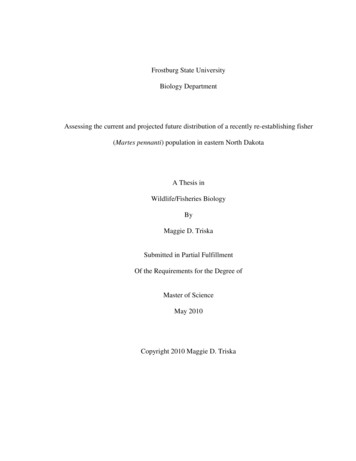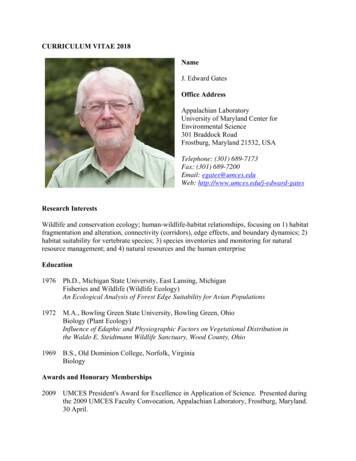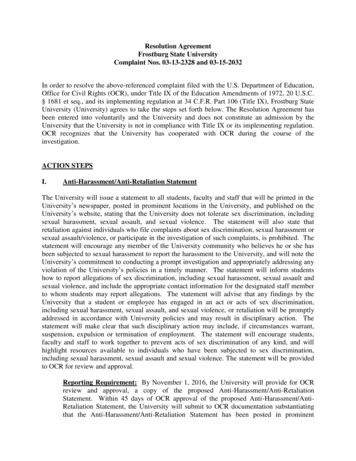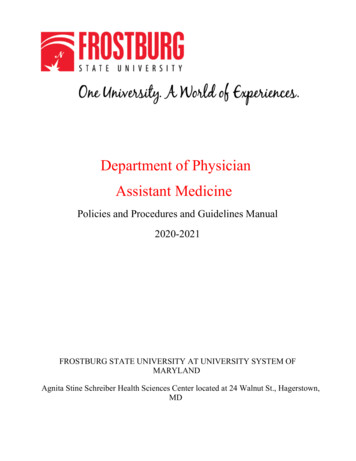
Transcription
Frostburg State UniversityBiology DepartmentAssessing the current and projected future distribution of a recently re-establishing fisher(Martes pennanti) population in eastern North DakotaA Thesis inWildlife/Fisheries BiologyByMaggie D. TriskaSubmitted in Partial FulfillmentOf the Requirements for the Degree ofMaster of ScienceMay 2010Copyright 2010 Maggie D. Triska
iiThe signatories below indicate that they have read and approved the Thesis of MaggieTriska. The absence of a signature reflects a dissenting vote.Signatories:Dr. Thomas L. Serfass, Professor of Wildlife EcologyMajor ProfessorDateDr. Dorothy Fecske, Adjunct Assistant Professor of BiologyCommittee MemberDateDr. Dan Fiscus, Assistant Professor of BiologyCommittee MemberDateDr. William L. Seddon, Professor of BiologyChair of Biology DepartmentDateDr. R. Scott Fritz, Associate Professor of BiologyBiological Sciences Graduate Program CoordinatorDateDr. Joseph M. Hoffman, Professor of Physics & EngineeringDean of College of Liberal Arts & SciencesDate
iiiSYNOPSISFishers (Martes pennanti) were extirpated from North Dakota during the late 19thcentury; however, there has been an increase in verified fisher sightings over the past 10years, which likely includes individuals from an expanding Minnesota population. Ievaluated fishers’ current and projected future distribution in the eastern half of NorthDakota through verified reports, presence-absence field data, and simulation modeling.Additionally, the Red River of the North (North Dakota and Minnesota border)experienced an extreme flood event, which inundated all riparian forests within the studyarea from about 23 March–22 May 2009 and I also examined the effects of this extremeflood event on detection rates between 2008 and 2009 on a portion of the Red River.Verified reports (2002–2007) were obtained from the North Dakota Game andFish Department and field data was obtained from population surveys conducted duringthe summers of 2008 and 2009 using enclosed track-plates and remote cameras.Detection devices were placed within the minimal and fragmented forests of easternNorth Dakota including the Forest, Goose, Park, Pembina, Red, Sheyenne, Tongue, andTurtle Rivers and the Pembina Hills. Fishers’ potential distribution and occupancy weresimulated using the model, HexSim, based on population parameters and habitatpreferences determined from prior studies in Minnesota and other states and provinces.Multiple scenarios were conducted, which differed in dispersal distance (10 km, 30 km,and 75 km) and habitat categories (forest vs. non-forest and 11 habitat categories). I alsocompared detection rates observed during the summers of 2008 (16 Jun–1 Aug) and 2009(1 Jun–18 Aug) along the Red River from Grand Forks, North Dakota to Pembina, NorthDakota where extreme flooding occurred.
ivMy research established that fishers are no longer extirpated from North Dakota.Verified reports were mostly concentrated in the northeast portion of the state (12 of 16reports; 75%) and few reports occurred farther south (Sheyenne National Grasslands; 2 of16 reports; 12.5%) and west (Devil’s Lake and the Turtle Mountains; 2 of 16 reports;12.5%). I obtained fisher detections at all rivers and regions surveyed in 8 of 12 counties;however detection rates were higher in the northeast and lower in the southeastern part ofthe state. Based on verified reports and survey data the current distribution of fishers ineastern North Dakota was found to be primarily within the northeast corner of the statewith few detections and reports occurring south of the Goose River or west of thePembina Hills.Simulation modeling indicated the landscape of eastern North Dakota contained5% and 10% of preferred fisher habitat depending on the base map, but fishers werepredicted to occupy less than was available varying by dispersal distance (20-50% at 10km dispersal distance, 55-79% at 30-km dispersal distance, and 79% at 75-km dispersaldistance) over 250 years. Habitat potential estimates ranged from 97.3 ( 7.9 SE) femalesat 10 km dispersal distance to 591.0 ( 7.5 SE) females at 75-km dispersal distance. Themodel scenarios were better at predicting occupancy of large patches than smallfragmented patches and identified regions where populations were most likely to persistin the future. Overall the results and predictability of the model would be greatlyimproved through additional behavioral studies in the region.Although, fishers were detected throughout the study area during both years ofsampling along the Red River, unexpectedly, detection rates were much higher in 2009than 2008 (28 out of 35 sites [80%] and 25 out of 57 sites [44%], respectively). The
voutcome of the study demonstrates that fishers were able to persist in the regionfollowing a severe, multi-month flood that inundated most of the forest habitat.
viACKNOWLEDGEMENTSI would like to thank my advisor, Dr. Thomass Serfass, for being instrumental inmy education at Frostburg. Steve Loughry was invaluable to me in the field and back atFSU. The other FSU graduate students were helpful in their discussions and advice. Myfamily and friends offered encouragement and support. Nathan Schumaker provided mewith advice and model assistance, and my project greatly benefited from our interactions.My committee members Dr. Dorothy Fecske and Dr. Daniel Fiscus provided helpfulcritiques and guidance on my thesis. The North Dakota landowners permitted landaccess, and also provided hours of conversation and enjoyment. The people of easternNorth Dakota will always have my respect and gratitude. Finally, thank you to theBiology Department at FSU and the North Dakota Game and Fish Department for givingme the opportunity to complete my Masters and conduct research in North Dakota.
viiTABLE OF CONTENTSSYNOPSIS . IIACKNOWLEDGEMENTS. VITABLE OF CONTENTS . VIICHAPTER 1: THE FISHER: INTRODUCTIONDescription.1Distribution and Range .2Habitat .3Foraging .5Activity Patterns .5Communication .6Home Range .7Dispersal .7Survey Techniques .8Modeling Techniques .9Objectives .10Literature Cited .11CHAPTER 2: VERIFIED REPORTS, FIELD SURVEYS, AND SIMULATION MODELINGAbstract .19Introduction .20Methods .22Study Area .22Model .24Procedure .24Verified Reports .25Field Data .25HexSim Scenarios .27Results .31Verified Reports and Field Data .31Model .32Area occupied .32
viiiHabitat Potential Estimate.33Prediction capability .34Discussion .36Literature Cited .40CHAPTER 3: PERSISTENCE OF FISHERS AFTER AN EXTREME FLOOD EVENTAbstract .103Introduction .104Methods .106Study Area .106Flood Delineation .108Presence-absence Sampling .109Results .111Flood Delineation .111Presence-absence Sampling .111Discussion .112Literature Cited .116APPENDICES .131
ixLIST OF TABLESCHAPTER 2: VERIFIED REPORTS, FIELD SURVEYS, AND SIMULATION MODELINGTable 2.1. The proportion of forest in 10-km segments (extending 500 m in eachdirection) along the rivers surveyed in 2008 and 2009 in eastern North Dakota forfishers. The proportion of forest ranged from 12% on the Forest River to 43% on thePembina River. .46Table 2.2. HexSim habitat inputs (used to calculate hexagon values) based on knownfisher preference (Arthur et al. 1989, Buskirk and Powell 1994, Jones and Garton 1994,Proulx et al. 1994) and habitat present in the eastern half of North Dakota. .47Table 2.3. Sixteen verified fisher reports (carcasses) were obtained in eastern NorthDakota from 2002–2007 by the North Dakota Game and Fish Department. Thenumber of reports ranged from 0 to 5 over the 6-year period, with males being morecommonly observed (11 males, 5 females). .48Table 2.4. The number of verified fisher reports obtained in eastern North Dakotafrom 2002–2007 by the North Dakota Game and Fish Department in by county. Thenumber of reports ranged from 1 in Benson, Barnes, Ransom and Rollete counties to 4in Walsh county. .49Table 2.5. The number of fisher survey and detection sites by river from presenceabsence sampling conducted during the summers of 2008 and 2009 in eastern NorthDakota. Detection rates ranged from 21% on the Goose River to 63% in the PembinaHills. .50Table 2.6. The number of fisher survey and detections sites in eastern North Dakotaduring the summers of 2008 and 2009 by county. Detection rates ranged from 0% inBarnes, Nelson, Ransom, and Richland counties to 67% in Cavalier county. .51Table 2.7. Habitat potential estimates of female fishers in eastern North Dakota basedon simulations conducted in HexSim over 250 years. The number of females increasedwith dispersal distance and time in Map-1 and Map-2. .52Table 2.8. Predicted home ranges sizes of female fishers in eastern North Dakotabased on simulations conducted in HexSim. Home ranges had set min-max values of7.9–23.3 km2 in the model. Predicted home range size ranged from 18.06 km2 (10-kmdispersal distance in Map-1) to 21.98 km2 (30-km dispersal distance in Map-2). .53Table 2.9. Habitat potential estimates of female fishers in eastern North Dakotaderived from the total amount of available habitat and the mean home range estimatesof the model. Census estimates were generated from HexSim and represent thepredicted population size of simulation replicates. .54
xTable 2.10. Survey sites (non-detection and detection) compared to model predictionsat 10-km, 30-km, and 75-km dispersal for Map-1. The areas surveyed had the samepredicted occupancy at 30-km and 75-km dispersal distances. .55Table 2.11. Survey sites compared to model predictions at 10-km, 30-km, and 75-kmdispersal for Map-2. The areas surveyed areas had the same predicted occupancy at30-km and 75-km dispersal distances. .56CHAPTER 3: PERSISTENCE OF FISHERS AFTER AN EXTREME FLOOD EVENTTable 3.1. Summary of fisher detections during surveys conducted in the summers of2008 and 2009 along the Red River of the North in northeastern North Dakota. .120APPENDIX B: MINNESOTA HEXSIM INPUTSTable B.1. Reproduction matrix input for HexSim used to simulate the fisher life cyclein Minnesota. .140Table B.2. Survival rates by age class used for simulating fisher life cycle inMinnesota. .141APPENDIX C: COORDINATES OF SURVEY AND DETECTION SITESTable C.1. The latitude and longitude (WGS 1984) coordinates of detection devices forfisher presence-absence set-up in eastern North Dakota during the summers of 2008and 2009. .147Table C.2. The latitude and longitude (WGS 1984) coordinates of detection deviceswhich received fisher detections in eastern North Dakota during the summers of 2008and 2009. .150
xiLIST OF FIGURESCHAPTER 2: VERIFIED REPORTS, FIELD SURVEYS, AND SIMULATION MODELINGFigure 2.1. The study area in eastern North Dakota surveyed for fishers during thesummers of 2008 and 2009. .57Figure 2.2. Flow chart of the model HexSim (adapted from Schumaker 1998). HexSimwas used to simulate the expansion of fishers into eastern North Dakota from westernMinnesota. .59Figure 2.3. Location of survey sites obtained during presence-absence sampling forfishers in eastern North Dakota during the summers of 2008 and 2009. .61Figure 2.4. HexMap (forest vs. non-forest; Map-1) of eastern North Dakota on whichfisher distribution was simulated. All forest was given a value of 10 and all non-foresta value of 0 to construct hexagons. .63Figure 2.5. HexMap (11 habitat categories; Map-2) of eastern North Dakota on whichfisher distribution was simulated. For habitat rankings see Table 2.2. .65Figure 2.6. Area used for the simulation of fishers in eastern North Dakota, with thelargest forest regions indicated (Devil’s Lake, Pembina Hills, Turtle Mountains, andSheyenne National Grasslands). .67Figure 2.7. Verified fisher reports in North Dakota from 2002–2007 (labeled by genderwhen available). The majority of reports were male and occurred in northeastern NorthDakota. .69Figure 2.3. Location of detection sites obtained during presence-absence sampling forfishers in eastern North Dakota during the summers of 2008 and 2009. Detectionsoccurred north of the Goose River in the northeast region of the state. .71Figure 2.9. Detection rates by county from fisher presence-absence surveys in easternNorth Dakota conducted during the summers of 2008 and 2009. Detection rates werehighest in the northeast and lowest in the southeast.73Figure 2.10. The proportion of forest occupied in Map-1 by fishers in eastern NorthDakota by dispersal distance (10, 30, and 75 km). The amount of time it took to reachmaximum occupancy varied by dispersal distance and ranged from 10 years at the 75km dispersal distance to 150 years at the 30-km dispersal distance. The amount ofavailable habitat occupied ranged from 51% at the 10-km dispersal distance to 79% atthe 30- and 75-km dispersal distances.75Figure 2.11. The proportion of forest occupied in Map-2 by fishers in eastern NorthDakota by dispersal distance (10, 30, and 75 km). The amount of time it took to reachmaximum occupancy varied by dispersal distance and ranged from 10 years at the 10and 75-km dispersal distances to 75 years at the 30-km dispersal distance. The amount
xiiof available habitat occupied ranged from 17% at the 10-km dispersal distance to 79%at the 30- and 75-km dispersal distances. After year 100 the area occupied decreasedin the 30-km dispersal distance scenarios. .77Figure 2.12. The study area of eastern North Dakota showing a) HexMap of forest vs.non-forest (Map-1) and predicted occupancy by fishers with 10-km maximum dispersal(100 replicates) at: b) 10 years, c) 50 years, and d) 250 years. .79Figure 2.13. The study area of eastern North Dakota showing a) HexMap of 11 habitatcategories (Map-2) and predicted occupancy by fishers with 10-km maximum dispersal(100 replicates) at: b) 10 years, c) 50 years, and d) 250 years. .81Figure 2.14. The study area of eastern North Dakota showing a) HexMap of forest vs.non-forest (Map-1) and predicted occupancy by fishers with 30-km maximum dispersal(100 replicates) at: b) 10 years, c) 50 years, and d) 250 years. .83Figure 2.15. The study area of eastern North Dakota showing a) HexMap of 11 habitatcategories (Map-2) and predicted occupancy by fishers with 30-km maximum dispersal(100 replicates) at: b) 10 years, c) 50 years, and d) 250 years. .85Figure 2.16. The study area of eastern North Dakota showing a) HexMap of forest vs.non-forest, b) predicted occupancy by fishers after 10 years with a maximum dispersalof 75-km (100 simulations), and c) location of verified fisher reports and detections. .87Figure 2.17. The study area of eastern North Dakota showing a) HexMap of 11 habitatcategories, b) predicted occupancy by fishers after 10 years with a maximum dispersalof 75-km (100 simulations), and c) location of verified fisher reports and detections. .89Figure 2.18. Habitat potential estimates of female fishers in eastern North Dakotabased on scenarios of with varying dispersal distance for Map-1 (forest vs. non-forest).Overall as dispersal distances increased the population size increased and ranged from97.3 ( 7.9 SE) females at the 10-km dispersal distance to 211.2 ( 5.4 SE) females atthe 75-km dispersal distance. .91Figure 2.19. Habitat potential estimates of female fishers in eastern North Dakotabased on scenarios of with varying dispersal distance for Map-2 (11 habitat categories).Overall as dispersal distances increased the population size increased and ranged from120.2 ( 4.6 SE) females at 10 km dispersal distance to 591.0 ( 7.5 SE) females at 75km dispersal distance. .93Figure 2.20. The study area of eastern North Dakota showing a) HexMap of forest vs.non-forest, b) predicted occupancy by fishers after 10 years with a maximum dispersalof 10-km (100 simulations), and c) location of verified fisher reports and detections. .95Figure 2.21. The study area of eastern North Dakota showing a) HexMap of forest vs.non-forest, b) predicted occupancy by fishers after 10 years with a maximum dispersalof 30-km (100 simulations), and c) location of verified fisher reports and detections. .97
xiiiFigure 2.22. The study area of eastern North Dakota showing a) HexMap of 11 habitatcategories, b) predicted occupancy by fishers after 10 years with a maximum dispersalof 10-km (100 simulations), and c) location of verified fisher reports and detections. .99Figure 2.23. The study area of eastern North Dakota showing a) HexMap of 11 habitatcategories, b) predicted occupancy by fishers after 10 years with a maximum dispersalof 30-km (100 simulations), and c) location of verified fisher reports and detections.101CHAPTER 3: PERSISTENCE OF FISHERS AFTER AN EXTREME FLOOD EVENTFigure 3.1. Study area along the Red River of the North in northeastern North Dakotawhere surveys were conducted in riparian forests to assess the presence anddistribution of fishers, summers of 2008 and 2009. .121Figure 3.2. The distribution of sample sites (a) placed along the Red River of theNorth in northeaster North Dakota to detect fishers during summers 2008 (n 57) and2009 (n 35). Fishers were detected (b) at 25 (44%) of the sample sites during 2008and 28 (80%) of the sample sites during 2009. .123Figure 3.3. The extent of flooding along the Red River of the North (delineated fromLandsat 5 imagery on 10 Apr 2009) and the distribution of forest patches in the studyarea along the Red River of the North in northeastern North Dakota. .125Figure 3.4. Gauge levels from USGS stations (Grand Forks, North Dakota; Oslo,Minnesota; Drayton, North Dakota; and Pembina, North Dakota) from January 2008–September 2009 along the Red River of the North in northeastern North Dakota.Periods when surveys were conducted to detect fishers, 2008 and 2009, are indicatedwith vertical rectangles and are labeled by year. The dashed, horizontal line througheach graph represents flood stage for the specific gauge station and black dots signifythe date (10 Apr 2009) of the Landsat 5 imagery used to delineate the flood extent. .127Figure 3.5. Flooding along the Red River of the North in Pembina, North Dakota on 10April 2009. A fisher was detected at a site (indicated by the dot) on 4 June 2009, 15days after the river receded below flood stage and 75 days after the first day of theflood). .129APPENDIX A: LEAST COST PATH ANALYSISFigure A.1. Map of North Dakota with the study area of least cost path (LCP) analysisof fisher movement based on habitat preferences surrounded in a black rectangle. .133Figure A.2. Model used to create a least cost path (LCP) line of fisher movementbased on habitat preferences in eastern North Dakota from the Pembina Hills to theSheyenne River. .135Figure A.3. Map of eastern North Dakota and the least cost path (LCP) line createdbased on fisher habitat preferences. .137APPENDIX B: MINNESOTA HEXSIM INPUTS
xivFigure B.1. Northern Minnesota HexMap containing forest vs. non-forest habitatcategories. Outputs from scenarios completed on the Minnesota forest only HexMapwere applied to the eastern North Dakota forest only HexMap to simulate fisherdistribution. .142Figure B.2. Northern Minnesota HexMap containing all 11 habitat categories. Outputsfrom scenarios completed on the northern Minnesota category HexMap were applied tothe eastern North Dakota category HexMap to simulate fisher distribution. .144
xvList of AppendicesAPPENDIX A: LEAST COST PATH ANALYSIS .131APPENDIX B: MINNESOTA HEXSIM INPUTS.139APPENDIX C: COORDINATES OF SURVEY AND DETECTION SITES .146
1CHAPTER 1The Fisher: IntroductionDescriptionThe fisher (Martes pennanti) is a mesocarnivore of the Family Mustelidae(Powell 1981, 1993, Douglas and Strickland 1987). Fishers have dark brown, almostblack, fur and may have a few white patches of fur near the neck and throat (Powell1981, Hazard 1982, Nowak and Paradiso 1983, Forsyth 1985, Powell et al. 2003). Theyhave stout legs, long, dense bodies, slightly rounded ears, and long, bushy tails (Godin1977, Hamilton and Whitaker 1979, Strickland et al. 1982, Forsyth 1985, Douglas andStrickland 1987). Fishers have unsheathed, semi-retractable claws that assist them inclimbing (Powell 1981, Forsyth 1985, Powell et al. 2003).Fishers are sexually dimorphic (Godin 1977). Adult males range from 90 to 120cm in length and typically are much larger than females, which range 75 to 95 cm inlength (Godin 1977, Hamilton and Whitaker 1979, Moors 1980, Strickland et al. 1982,Forsyth 1985). In both sexes, the tail comprises approximately 30 percent of the totalbody length (Powell 1981, Nowak and Paradiso 1983, Powell et al. 2003). The weight ofa fisher generally is between 3.5 to 5.5 kg for males and 2.0 to 2.5 kg for females (Powell1981, Powell et al. 2003).Male and female fishers are capable of breeding at 1 year of age (Eadie andHamilton 1958, Wright and Coulter 1967, Mead 1994); however, males 2 years havegreater reproductive success (Wright and Coulter 1967, Mead 1994). Fishers exhibitdelayed implantation, which results in a 10-11 month gestation period (LaBeree 1941,Hall 1942, Mead 1989) followed by the birth of a typical litter of 2-3 altricial kits (Hall
21942, Hazard 1982, Mead 1994). Breeding occurs in the spring (March – April)approximately 3-8 days after the female gives birth (LaBeree 1941, Hall 1942, Douglasand Strickland 1987).Distribution and RangeFishers occur only in North America (De Vos 1952, Powell 1981, 1993, Hazard1982, Powell et al. 2003). Their historical range extended across Canada, southward intoportions of California, Montana, Idaho, Wyoming, New Mexico, North Dakota,Minnesota, Illinois, Iowa, Tennessee, and the northeastern United States (Hagmeier 1956,Powell 1993). Within these regions, their range was restricted to landscapes withadequate canopy cover or forested areas (Brander and Books 1973).The original widespread distribution of fishers declined during the late 19thcentury (Hagmeier 1956, Balser and Longley 1966, Powell 1993). At that time,remaining populations in the United States occupied forests in Maine, California,Minnesota, New York, and New Hampshire (Brander and Books 1973). The speciesdecline was linked to forest fragmentation (logging, urbanization, and fires), trapping(Brander and Books 1973, Strickland et al. 1982, Douglas and Strickland 1987, Powell1993), and predator control (Douglas and Strickland 1987). Fisher populations
Major Professor Dr. Dorothy Fecske, Adjunct Assistant Professor of Biology Date Committee Member Dr. Dan Fiscus, Assistant Professor of Biology Date . Biology Department at FSU and the North Dakota Game and Fish Department for giving me the opportunity to complete my Masters and conduct research in North Dakota.










